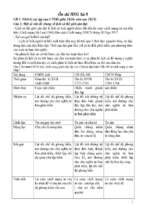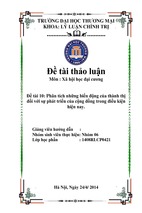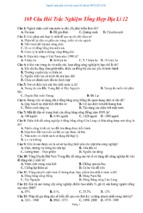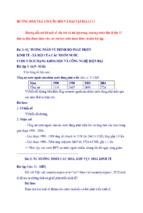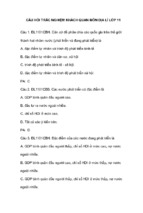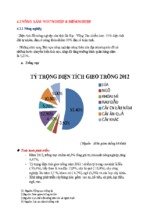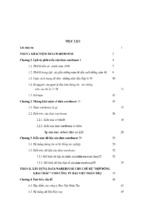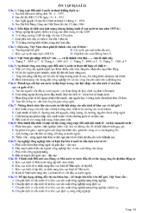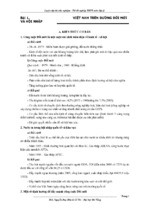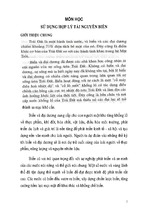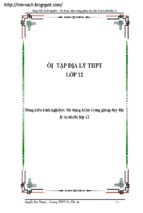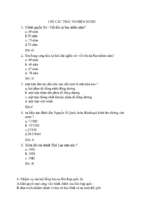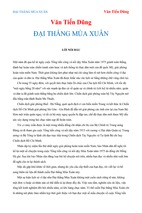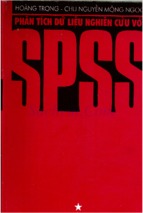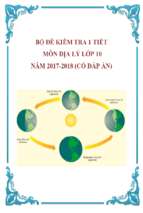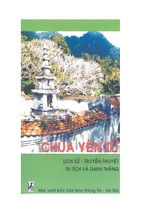Chapter 42
Onion
Botanical Name:
Synonyms:
Family:
Common Names:
Allium cepa L.
Bulb onions, multiplier onions, shallots, potato onion, tree
onion, palandu.
Liliaceae (Amaryllidaceae or Alliaceae).
French: oignon; German: Zwiebel; Italian: cipolla; Spanish:
cebolla; Hindi: pyaj.
Introduction
History
Onion is one of the oldest vegetables known to mankind dating back to 3,500 years.
Onion plant is the most often depicted plant in Egyptian tomb paintings. An inscription on the Great Pyramid of Cheops indicates “100 talents of silver had been spent on
onions, garlic, and radishes with which the slave labor were reimbursed, in lieu of
money, for their part in building the pyramid in 2500 BC.” It is the plant that the
Greeks and Romans had a love–hate relationship with, both praising its healing properties and damning its odor. It is also the plant that Alexander the Great fed to his
troops to give them strength and vigor for battle. The ancient Egyptians loved onion
and one of the varieties evoked as a deity and worshipped. The Egyptians ate it raw.
Onion was one of the staple foods for the slaves who built the Giant Pyramid. Later
the Israelites mourned the loss of Egyptian onions on their way to the Promised Land.
It is mentioned in the Bible (Numbers 11: 5). The English name onion is believed to
have been derived from the Roman name unionem or unio, referring to its single bulb.
Romans introduced onion to Britain, and Emperor Nero took it for cold, coughs, and
sore throats. It was regarded as an aphrodisiac and a symbol of fertility.
435
D.J. Charles, Antioxidant Properties of Spices, Herbs and Other Sources,
DOI 10.1007/978-1-4614-4310-0_42, © Springer Science+Business Media New York 2013
436
42
Onion
Producing Regions
Onion is native to western Asia and the Mediterranean. It has long been cultivated
worldwide and with many different varieties. The USA, Egypt, Japan, Hungary,
Czechoslovakia, France produce dehydrated onions.
Botanical Description
Onion is a perennial or biennial herb that grows from a bulb up to 1.2 m (3 ft) high.
Stems are erect and carry an umbel of flowers. The leaves are narrow, basal, hollow
cylindrical, and blue-green in color. Flowers are white or pink or purple, small in
globe-shaped umbels. The fruit is a capsule containing black seeds. There are many
different varieties of onions, the most common ones being the white globe, yellow
globe, and red globe.
Parts Used
Fleshy bulb (fresh or dry, frozen, chopped onions, powder, charred powder, flakes,
onion salt, onion juice), essential oil. Fresh onion comes chopped, sliced, or diced.
Dried onion comes granulated, powdered, minced, chopped, ground, or toasted.
Flavor and Aroma
It has a pungent, sweet aroma. It has a pungent bitter taste and flavor.
Active Constituents
The activity and pungent smell is due to several sulfur-containing compounds—
mainly sulfoxides, but also cepaenes (a-sulfinyl-disulfides). Sulfoxides (such as transS-(1-propenyl)-l-(+)-cysteinesulfoxide, an isomer of alliin) are present in the intact
bulb, but they are converted by enzymatic action (by alliinase) into various sulfides
that spontaneously form disulfides. These compounds can easily form disulfide
bonds with SH-groups of proteins and thus alter their biological activities. Other
constituents present are phenolic acids (caffeic, sinapic), flavonoids, sterols, saponins,
sugars, vitamins, pectins, anthocyanins, and essential oils Singh et al. (2004).
437
Preparation and Consumption
Table 42.1 Nutrient composition and ORAC values of onion powder
Nutrient
Units
Value per 100 g
Water
g
5.39
Energy
kcal
341
Protein
g
10.41
Total lipid (fat)
g
1.04
Carbohydrate, by difference
g
79.12
Fiber, total dietary
g
15.2
Sugars, total
g
6.63
Calcium, Ca
mg
384
Vitamin C, total ascorbic acid
mg
23.4
Vitamin B-6
mg
0.718
Vitamin B-12
mcg
0.00
Vitamin A, RAE
mcg_RAE
0
Vitamin A, IU
IU
0
Vitamin D
IU
0
Vitamin E (alpha-tocopherol)
mg
0.27
Fatty acids, total saturated
g
0.219
Fatty acids, total monounsaturated
g
0.202
Fatty acids, total polyunsaturated
g
0.310
H-ORAC
mmol TE/100 g
3,858
L-ORAC
mmol TE/100 g
431
Total-ORAC
mmol TE/100 g
4,289
TP
mg GAE/100 g
861
Source: USDA National Nutrient Database for Standard Reference, Release 24 (2011)
Quercetin is one of the major compounds (Rodriguez Galdon et al. 2008; Lu et al.
2011). The nutritional constituents and ORAC values of onion powder are given in
Table 42.1.
Preparation and Consumption
White onions are the most pungent and strong, yellow onions are slightly milder
and sweeter, red (purple) onions are the mildest and also the sweetest. Onions add
color, flavor, and crunchiness to foods. The dry or fresh onion is used raw, sauteed,
steamed, broiled, boiled, pickled, marinated, stuffed, cooked and pureed, baked,
deep fried in batter, and caramelized. Onions are great in cheese spreads, savory
pies, stuffings, soups, stocks, casseroles, salads, breads, pates, meat loaves, steamed
vegetable combinations, and stir fries. They can be added to sauces, soups, and
stews. Yellow onions turn a rich, dark brown when cooked and give French Onion
Soup its tangy sweet flavor. It is essential in soups, stocks, marinades, all types of
meat and chicken dishes; in salads, pickles, and chutneys. It is an important ingredient
in all cuisines worldwide. In India and China, onion is a major ingredient in lots of
dishes. Dehydrated onions are used in a variety of dishes like baked goods, pickles,
438
42
Onion
relishes, condiments, meat seasonings, Dutch loaf, German bologna, salad dressing
mixes. Yellow onions are good for soups, sauces or stews for long cooking. Sweet
is good for baked, battered, and fried food. The red onions are used raw in
sandwiches and salads.
Medicinal Uses and Functional Properties
Onion is used in the treatment of appetite loss and prevention of age-related changes
in blood vessels (arteriosclerosis). Onions and juice may be used to treat minor
digestive disturbances and is used to overcome the immediate effects of insect
stings. Juice mixed with sugar or honey is a traditional treatment for colds and
cough. The treatment of dysentery, wounds, scars, keloids, asthma, and diabetes are
among the many traditional uses.
Onion is known to have anticancer, antimicrobial, hypoglycemic, anti-platelet
aggregation, anti-asthmatic, antiallergic, lipid- and blood pressure-lowering effects
(Williamson and Manach 2005; Sengupta et al. 2004; Colli and Amling 2009; Yu
et al. 2010; Taj Eldin et al. 2010; Gorinstein et al. 2011; Jung et al. 2011; Kim et al.
2011; Mantawy et al. 2011; Viry et al. 2011; Zhou et al. 2011). Onion bulbs have
been found to be a rich source of dietary flavonoids. Different flavonoids have been
characterized and quercetin and its glycosides are the most important ones (Boyer
et al. 2005; Wong and Rabie 2008; Slimestad et al. 2007). Higher concentrations of
quercetin occur in the outer dry layers of onion bulb (Smith et al. 2003). There are
a few studies on the antidiabetic effects of onion skin extract in vivo (Nemeth and
Piskula 2007; Kanter et al. 2007). Clinical trials hitherto focused mainly on garlic
(A. sativum) but there is good clinical evidence of efficacy of onions in treating
appetite loss and preventing arteriosclerosis. Onion acts as stimulant, diuretic,
expectorant, lowers blood sugar, cholesterol (Augusti 1990). Onion oil contains
heart stimulant, and increases coronary flow (Augusti 1990). Onion is useful in
preventing oral infections and toothache (Chevallier 1996). Essential oil of onion
was shown to be potent inhibitor of yeast growth (Kim et al. 2004). They were also
found to be antibacterial. Oral administration of onion extract was shown to prevent
cadmium-induced renal dysfunction (Ige et al. 2009). Quercetin an active constituent of onion, also possesses antimicrobial property (Geoghegan et al. 2010). Onion
extract and quercetin play a role in the anti-scar effect in skin through up-regulation
of MMP-1 expression, implying this agent is a promising material for reducing scar
formation (Cho et al. 2010). Crude Allium cepa was shown to produce hypoglycemic effects, and thus could be used as a dietary supplement in management of type
1 and/or type 2 diabetes mellitus (Taj Eldin et al. 2010). Treatment with onion and
garlic methanol extracts was found to prevent loss in body weight, decrease plasma
glucose level, and significantly ameliorate the hyperalgesia, TBARS, serum nitrite,
and GSH levels in diabetic mice. The onion extract had higher total phenolic content (Bhanot and Shri 2010). Quercetin and ethyl alcohol extract of onion skin were
found to have blood glucose lowering potential via the a-glucosidase inhibition
Antioxidant Properties
439
(Kim et al. 2011). Zhou et al. (2011) reported that in a meta-analysis, consumption
of high levels of Allium vegetables (onions, garlic, shallots, leeks, chives, and so
forth) reduced the risk for gastric cancer.
Antioxidant Properties
The antioxidant activity of onion and onion scales has been studied in several models and assays (Pratt 1965; Gazzani et al. 1998; Cao et al. 1996; Vinson et al. 1998;
Yang et al. 2004; Shon et al. 2004; Eguchi et al. 2005; Ly et al. 2005; Yamamoto
et al. 2005; Blomhoff 2005; Ramos et al. 2006; Stratil et al. 2006; Slimestad et al.
2007; Huang et al. 2009; Murota et al. 2007; Meyers et al. 2008; Zielinska et al.
2008; Dini et al. 2008; Takahashi and Shibamoto 2008; Gorinstein et al. 2008;
Javadzadeh et al. 2009; Khaki et al. 2009; Pellegrini et al. 2009; Veda et al. 2008;
Singh et al. 2009; Roldán-Marín et al. 2009; Azuma et al. 2010; Chang et al. 2010;
Benitez et al. 2011; Cazzola et al. 2011; Lynett et al. 2011; Shim et al. 2011;
Stankevicius et al. 2011). Onion bulbs are a rich source of flavonoids and contribute
to the overall intake of flavonoids (Lee et al. 2008). Quercetin, a bioflavonoid found
in several fruits and vegetables, including onions, has antioxidant and antiinflammatory activity and prevents cancer (Shaik et al. 2006; Hung 2007), reduces
the risk of coronary heart disease and stroke (Edwards et al. 2007; Terao et al. 2008;
Mennen et al. 2004). Quercetin was shown to reduce blood pressure in hypertensive
subjects (Edwards et al. 2007). Hubbard et al. (2004) studied the relationship
between the ingestion of dietary quercetin and platelet function. Ingestion of quercetin was found to inhibit platelet aggregation and the collagen-stimulated tyrosine
phosphorylation of total platelet proteins. Their study implicates quercetin as a
dietary inhibitor of platelet cell signaling and thrombus formation. Meyers et al.
(2008) reported that onion-fed mice demonstrated the greatest increases in
GSH:GSSG ratios and the greatest decreases in protein-mixed disulfide levels of all
diets compared. Rutin, a flavonoid in onions, was found to reduce the level of nitrite
in LPS-stimulated BALD/c mice, while the elevated levels of TNF-alpha in LPSstimulated animals was lowered (Guruvayoorappan and Kuttan 2007). Galluzzo
et al. (2009) reported quercetin to kill HeLa cells through an ERalpha-dependent
mechanism involving caspase- and p38 kinase activation and hence has great potential as chemopreventive actions on cancer growth. Rassi et al. (2005) reported both
quercetin and rutin to increase nuclear ERbeta protein and decrease ERalpha protein of osteoclast progenitors. In addition rutin was shown to reduce RANK protein,
while quercetin promoted apoptosis by cleavage of caspase-8 and caspase-3. Their
results suggest the anti-resorbing properties of flavonols to be mediated by ER proteins through inhibition of RANK protein or the activation of caspases. Both red
and white varieties of onion were found to preserve the bioactive compounds and
antioxidant potentials, and hinder the rise in plasma lipid levels and decrease in plasma
antioxidant activity of rats fed cholesterol (Gorinstein et al. 2010). Polyphenols present
in a large variety of dietary products including onion, was shown, under gastric
440
42
Onion
conditions to reduce nitrite to *NO that in turn exerts a biological impact as a local
relaxant (Rocha et al. 2009). Yamamoto et al. (2005) found the Welsh green onions to
reduce superoxide generation by suppressing the angiotensine II production and the
NADH/NADPH oxidase activity, increase the NO availability in the aorta, and thus
lower blood pressure in rats fed with HFS diet.
Methanolic extracts of outer scales and edible portions of onion were shown to
reduce cerebral infarct size and attenuate impairment in short memory and motor
coordination, and this was accompanied by a decrease in mitochondrial TBARS
(Shri and Singh 2008). Onion flesh or onion peel was shown to enhance the antioxidant status in aged Sprague Dawley rats and could be beneficial for the elderly in
lowering lipid peroxide levels (Park et al. 2007). Quercetin-supplemented diets
were shown to lower blood pressure and attenuate cardiac hypertrophy in rats with
aortic constriction (Jalili et al. 2006). Nishimura et al. (2006) in their experiment
found onion extracts and di-n-propyl trisulfide to have high ameliorative effect of
memory impairment. They further found that the hippocampus lipid hydroperoxide
in senescence-accelerated mouse P8 was decreased by the administration of di-npropyl trisulfide. These results they report suggest that di-n-propyl trisulfide present
in onions ameliorates memory impairment in SAMP8 mouse through its antioxidant effect. Onion peel hydroalcoholic extract was shown to reduce aortic contractions in rats possibly through inhibition of calcium influx but not involving NO,
cGMP, endothelium, and prostaglandins (Naseri et al. 2008). This hypotensive
effect could be due to quercetin in the extract and possibly the antioxidant activity,
and inhibition of vascular smooth muscle cells Ca2+ influx.
The effect of methanolic extract of onion on ischemic injury in heart-derived H9c2
cells in vitro and in rat hearts in vivo was studied by Park et al. (2009). They found the
extract to attenuate ischemia/hypoxia-induced apoptosis in heart-derived H9c2 cells,
through an antioxidant effect. Onion extract and quercetin has been shown to protect
against neuronal damage from transient cerebral ischemia (Hwang et al. 2009). They
reported quercetin and onion extract to decrease protein levels of 4-hydroxy-2-nonenal (a marker for LPO) in the ischemic CA1. Vijayababu et al. (2006) found quercetin
to be a p53-independent effector of apoptosis in prostate cancer cells via its modulation of the Bax/Bcl-2 protein ratio because there was an increased level of IGFBP-3
associated with increased proapoptotic proteins and apoptosis in response to quercetin. Kumari and Augusti (2007) found that both gugulipid and SMCS cause reduction
of endogenous lipogenesis, increase catabolism of lipids and subsequent excretion of
metabolic by-products through the intestinal tract.
Onion, a rich source of flavonoids, has been shown to favorably modulate the
process of carcinogenesis (Krishnaswamy (2008). Onion has been found to reduce
the incidence of cancers in several tissues in epidemiological studies (Gao et al.
1999; Dorant et al. 1996). The chemopreventive effects of onion (Wu et al. 2006)
are mediated by the enhancement of the activity of specific mixed-function oxidases
that depress the activation of carcinogens (Chun et al. 2001), increased synthesis of
GSH that directly protects cells from damage by free radicals (Banerjee et al. 2002;
Bose et al. 2002; Scharf et al. 2003), induction of cell cycle arrest and apoptosis in
cancer cells (Sun et al. 2004), and induction of phase II enzymes which enhance
Antioxidant Properties
441
detoxification and excretion of potential carcinogens and reduction of the formation
of DNA adducts (Munday et al. 2003). In their study on quercetin, Hung (2007)
found it to inhibit A549 lung carcinoma cell proliferation and this was associated
with the activation of extracellular-regulated kinase (ERK). Wenzel et al. (2004)
found quercetin from onions to alter the levels of a variety of proteins involved in
growth, differentiation, and apoptosis of colon cancer cells. This explains the anticancer activities of quercetin. Apigenin, a flavone, abundantly present in onions has
been shown to have cancer chemopreventive effects in an organ-specific format and
could be used for the development of cancer chemopreventive agent (Patel et al.
2007). Onion extracts have also been used in the prevention and treatment of hypertrophic scars (Zurada et al. 2006). Hubbard et al. (2006) reported that those who
preferentially consume high amounts of quercetin-containing foods like onion have
a reduced risk of thrombosis and potential CVD risk. They found collagen-stimulated platelet aggregation to be greatly inhibited after ingestion of high-quercetin
soup in a time-dependent manner. Al-Fayez et al. (2006) demonstrated that quercetin from onion and apples regulates COX-mediated and PGE-2 production and their
ability to attenuate prostanoid levels could be contributing to their chemopreventive
efficacy. Wu et al. (2006) in their research on onion oil found it to have chemopreventive action by inducing cell cycle arrest and apoptosis in tumor cells.
Onion extract was found to be significant for glucose concentration and body
weight for its antidiabetic effects. Thus onion intake is effective for lowering plasma
glucose concentrations and body weight (Kook et al. 2009). Oral administration of
onion was found to reduce the serum uric acid levels in hyperuricemic rats and
inhibited xanthine dehydrogenase (XDH) and xanthine oxidase (XO) activities
(Haidari et al. 2008).
El-Demerdash et al. (2005) investigated the effects of onion on the biochemical
parameters, enzyme activities, and lipid peroxidation in alloxan-induced diabetic
rats. They found the levels of glucose, urea, creatinine, and bilirubin to be
significantly increased in the plasma of alloxan-diabetic rats compared to the control group. The activities of AST, ALT, LDH and AlP, AcP were significantly
increased in plasma and testes of alloxan-diabetic rats, while these activities
decreased in the liver compared to the control group, the brain LDH was increased.
The concentration of TBARs and the activity of glutathione S-transferase in plasma,
liver, testes, brain, and kidney were increased in alloxan-diabetic rats. The altered
parameters were restored to normal levels with repeated doses of onion juice. These
results clearly show the antioxidant and antihyperglycemic effects of onion juice
(El-Demerdash et al. 2005).
Onion was shown to attenuate the Cd-induced oxidative damage in rat liver possibly via lipid peroxidation and enhanced antioxidant defense system (Obioha et al.
2009). Ola-Mudathir et al. (2008) studied protective role of onion on Cd-induced
testicular damage and spermiotoxicity. They found the aqueous extracts of onion to
offer protection against Cd-induced testicular oxidative damage and spermiotoxicity by reducing lipid peroxidation and increasing antioxidant defense in rats. Suru
(2008) studied the protective effects of onion on Cd-induced kidney damage in male
Wistar rats. The levels of renal LPO and GST were reduced while the levels of renal
442
42
Onion
GSH, SOD, CAT, and Na+/K+-ATPase were decreased in rats that received Cd alone.
Treatment with onion extract resulted in a significant dose-dependent restoration of
these parameters. Izawa et al. (2008) reported the protective effects of onion and
quercetin against the male reproductive toxicity induced by diesel exhaust particles
(DEP). Haleagrahara et al. (2009) studied the effect of quercetin on stress-induced
changes in oxidative biomarkers in the hypothalamus of rats and found the antioxidant
action of quercetin to be beneficial in the prevention and treatment of stress-induced
oxidative damage in the brain. They found forced swimming stress to produce a
severe oxidative damage in hypothalamus of rats but treatment with quercetin
significantly attenuated these stress-induced changes. Mastrangelo et al. (2006)
studied whether quercetin can afford protection from chromosome breaks induced
by atrazine. They found quercetin to significantly reduce the frequency of total
aberrations induced by atrazine. Their results suggest that quercetin may protect
against the genotoxic effects of atrazine. Lines and Ono (2006) showed that FRS
1000, a beverage containing flavonoids from onion peels improved male sexual
function. This was because FRS 1000 strongly inhibited phosphodiesterase 5A
(PDE 5A) which is important for treatment of erectile dysfunction. They also found
that quercetin was the flavonoid responsible for this activity. Murota et al. (2004)
showed that quercetin-4¢-glucoside, present in onion serves as a favorable antioxidant source for suppressing iron-induced oxidative stress in the intestinal tract. The
dried skin of red onion possesses ingredients with potential for skin-whitening
cosmetics with anti-tyrosinase activity (Arung et al. 2011a). Of the three phenolic
compounds, quercetin was found to have the highest antioxidative activity (Xue
et al. 2011). In enhanced meats (pork loin, belly cuts), onion showed strong antioxidant effect equal to sodium ascorbate and also showed strong antimicrobial
effect by inhibiting the growth of total bacteria (Park et al. 2008). Irradiation
increased the TBARS values of control ground beef, but addition of 0.5 % onion
reduced oxidative changes during storage (Yang et al. 2011). Quercetin-3¢-O-betad-glucoside from the methanol extract of dried skin of A. cepa, inhibited melanin
formation in B16 melanoma cells and mushroom tyrosinase. In addition, it exhibited strong antioxidant activity of 3.04 mmol TE/mmol. Thus quercetin-3¢-O-betad-glucoside could be useful for treating hyperpigmentation and for protecting
against oxidative stress (Arung et al. 2011b).
Regulatory Status
GRAS 182.20.
Standard
ISO 5559 (Dehydrated onion).
References
443
References
Al-Fayez M, Cai H, Tunstall R, Steward WP, Gescher AJ (2006) Differential modulation of
cyclooxygenase-mediated prostaglandin production by the putative cancer chemopreventive
flavonoids tricin, apigenin and quercetin. Cancer Chemother Pharmacol 58(6):816–825
Arung ET, Wijaya Kusuma I, Shimizu K, Kondo R (2011a) Tyrosinase inhibitory effect of quercetin 4¢-O-b-D-glucopyranoside from dried skin of red onion (Allium cepa). Nat Prod Res
25(3):256–263
Arung ET, Furuta S, Ishikawa H, Tanaka H, Shimizu K, Kondo R (2011b) Melanin biosynthesis
inhibitory and antioxidant activities of quercetin-3¢-O-beta-D-glucoside isolated from Allium
cepa. Z Naturforsch C 66(5–6):209–214
Augusti KT (1990) Therapeutic and medicinal values of onion and garlic. In: Brewster JL,
Robinowitch HD (eds) Onions and allied crops, vol III. CRC, Boca Raton, FL
Azuma K, Ippoushi K, Terao J (2010) Evaluation of tolerable levels of dietary quercetin for exerting its antioxidative effect in high cholesterol-fed rats. Food Chem Toxicol 48(4):1117–1122
Banerjee SK, Maulik M, Mancahanda SC, Dinda AK, Gupta SK, Maulik SK (2002) Dosedependent induction of endogenous antioxidants in rat heart by chronic administration of garlic. Life Sci 70(13):1509–1518
Benitez V, Molla E, Martin-Cabrejas MA, Aguilera Y, Lopez-Andreu FJ, Cools K, Terry LA,
Esteban RM (2011) Characterization of industrial onion wastes (Allium cepa L.): dietary fibre
and bioactive compounds. Plant Foods Hum Nutr 66(1):48–57
Bhanot A, Shri R (2010) A comparative profile of methanol extracts of Allium cepa and Allium
sativum in diabetic neuropathy in mice. Pharmacognosy Res 2(6):374–384
Blomhoff R (2005) Dietary antioxidants and cardiovascular disease. Curr Opin Lipidol 16(1):
47–54
Bose C, Guo J, Zimniak L, Srivastava SK, Singh SP, Zimniak P, Singh SV (2002) Critical role of
allyl groups and disulfide chain in induction of Pi class glutathione transferase in mouse tissues
in vivo by diallyl disulfide, a naturally occurring chemopreventive agent in garlic. Carcinogenesis
23(10):1661–1665
Boyer J, Brown D, Liu RH (2005) In vitro digestion and lactase treatment influence uptake of
quercetin and quercetin glucoside by the Caco-2 cell monolayer. Nutr J 4:1
Cao G, Sofic E, Prior RI (1996) Antioxidant capacity of tea and common vegetables. J Agric Food
Chem 44:4326–4331
Cazzola R, Camerotto C, Cestaro B (2011) Anti-oxidant, anti-glycant, and inhibitory activity
against a-amylase and a-glucosidase of selected spices and culinary herbs. Int J Food Sci Nutr
62(2):175–184
Chang HS, Ko M, Ishizuka M, Fujita S, Yabuki A, Hossain MA, Yamato O (2010) Sodium 2-propenyl thiosulfate derived from garlic induces phase II detoxification enzymes in rat hepatoma
H4IIE cells. Nutr Res 30(6):435–440
Chevallier A (1996) The encyclopaedia of medicinal plants. Dorling Kindersley, London
Cho JW, Cho SY, Lee SR, Lee KS (2010) Onion extract and quercetin induce matrix metalloproteinase-1 in vitro and in vivo. Int J Mol Med 25(3):347–352
Chun HS, Kim HJ, Choi EH (2001) Modulation of cytochrome P4501-mediated bioactivation of
benzo[a]pyrene by volatile allyl sulfides in human hepatoma cells. Biosci Biotechnol Biochem
65(10):2205–2212
Colli JL, Amling CL (2009) Chemoprevention of prostate cancer: what can be recommended to
patients? Curr Urol Rep 10(3):165–171
Dini I, Tenore GC, Dini A (2008) S-alkenyl cysteine sulfoxide and its antioxidant properties from
Allium cepa var. tropeana (red onion) seeds. J Nat Prod 71(12):2036–2037
Dorant E, van den Brandt PA, Goldbohm RA, Sturmans F (1996) Consumption of onions and a
reduced risk of stomach carcinoma. Gastroenterology 110(1):12–20
Edwards RL, Lyon T, Litwin SE, Rabovsky A, Symons JD, Jalili T (2007) Quercetin reduces blood
pressure in hypertensive subjects. J Nutr 137(11):2405–2411
444
42
Onion
Eguchi A, Murakami A, Ohigashi H (2005) Novel bioassay system for evaluating anti-oxidative
activities of food items: use of basolateral media from differentiated Caco-2 cells. Free Radic
Res 39(12):1367–1375
El-Demerdash FM, Yousef MI, El-Naga NI (2005) Biochemical study on the hypoglycemic effects
of onion and garlic in alloxan-induced diabetic rats. Food Chem Toxicol 43(1):57–63
Galluzzo P, Martini C, Bulzomi P, Leone S, Bolli A, Pallottini V, Marino M (2009) Quercetininduced apoptotic cascade in cancer cells: antioxidant versus estrogen receptor alpha-dependent
mechanisms. Mol Nutr Food Res 53(6):699–708
Gao CM, Takezaki T, Ding JH, Li MS, Tajima K (1999) Protective effect of allium vegetables
against both esophageal and stomach cancer: a simultaneous case-referent study of a highepidemic area in Jiangsu Province, China. Jpn J Cancer Res 90(6):614–621
Gazzani G, Papetti A, Massolini G, Daglia M (1998) Anti- and pro-oxidant activity of water soluble components of some common diet vegetables and the effect of thermal treatment. J Agric
Food Chem 46:4118–4122
Geoghegan F, Wong RW, Rabie AB (2010) Inhibitory effect of quercetin on periodontal pathogens
in vitro. Phytother Res 24(6):817–820
Gorinstein S, Leontowicz H, Leontowicz M, Namiesnik J, Najman K, Drzewiecki J, Cvikrová M,
Martincová O, Katrich E, Trakhtenberg S (2008) Comparison of the main bioactive compounds
and antioxidant activities in garlic and white and red onions after treatment protocols. J Agric
Food Chem 56(12):4418–4426
Gorinstein S, Leontowicz H, Leontowicz M, Jastrzebski Z, Najman K, Tashma Z, Katrich E, Heo
BG, Cho JY, Park YJ, Trakhtenberg S (2010) The influence of raw and processed garlic and
onions on plasma classical and non-classical atherosclerosis indices: investigations in vitro and
in vivo. Phytother Res 24(5):706–714
Gorinstein S, Leontowicz H, Leontowicz M, Najman K, Bielecki W, Ham KS, Kang SG, ParedesLopez O, Martinez-Ayala AL, Trakhtenberg S (2011) Aorta and liver changes in rats fed cholesterol-containing and raw vegetable-supplemented diets: experiments in vitro and in vivo.
J Agric Food Chem 59(13):7441–7451
Guruvayoorappan C, Kuttan G (2007) Rutin inhibits nitric oxide and tumor necrosis factor-alpha
production in lipopolysaccharide and concanavalin-a stimulated macrophages. Drug Metabol
Drug Interact 22(4):263–278
Haidari F, Rashidi MR, Keshavarz SA, Mahboob SA, Eshraghian MR, Shahi MM (2008) Effects
of onion on serum uric acid levels and hepatic xanthine dehydrogenase/xanthine oxidase activities in hyperuricemic rats. Pak J Biol Sci 11(14):1779–1784
Haleagrahara N, Radhakrishnan A, Lee N, Kumar P (2009) Flavonoid quercetin protects against
swimming stress-induced changes in oxidative biomarkers in the hypothalamus of rats. Eur J
Pharmacol 621(1–3):46–52
Huang Z, Wang B, Eaves DH, Shikany JM, Pace RD (2009) Total phenolics and antioxidant capacity of indigenous vegetables in the southeast United States: Alabama Collaboration for
Cardiovascular Equality Project. Int J Food Sci Nutr 60(2):100–108
Hubbard GP, Wolffram S, Lovegrove JA, Gibbins JM (2004) Ingestion of quercetin inhibits platelet aggregation and essential components of the collagen-stimulated platelet activation pathway
in humans. J Thromb Haemost 2(12):2138–2145
Hubbard GP, Wolffram S, de Vos R, Bovy A, Gibbins JM, Lovegrove JA (2006) Ingestion of onion
soup high in quercetin inhibits platelet aggregation and essential components of the collagenstimulated platelet activation pathway in man: a pilot study. Br J Nutr 96(3):482–488
Hung H (2007) Dietary quercetin inhibits proliferation of lung carcinoma cells. Forum Nutr 60:
146–157
Hwang IK, Lee CH, Yoo KY, Choi JH, Park OK, Lim SS, Kang IJ, Kwon DY, Park J, Yi JS, Bae
YS, Won MH (2009) Neuroprotective effects of onion extract and quercetin against ischemic
neuronal damage in the gerbil hippocampus. J Med Food 12(5):990–995
Ige SF, Salawu EO, Olaleye SB, Adeeyo OA, Badmus J, Adeleke AA (2009) Onion (Allium cepa)
extract prevents cadmium induced renal dysfunction. Indian J Nephrol 19(4):140–144
References
445
Izawa H, Kohara M, Aizawa K, Suganuma H, Inakuma T, Watanabe G, Taya K, Sagai M (2008)
Alleviative effects of quercetin and onion on male reproductive toxicity induced by diesel
exhaust particles. Biosci Biotechnol Biochem 72(5):1235–1241
Jalili T, Carlstrom J, Kim S, Freeman D, Jin H, Wu TC, Litwin SE, David SJ (2006) Quercetinsupplemented diets lower blood pressure and attenuate cardiac hypertrophy in rats with aortic
constriction. J Cardiovasc Pharmacol 47(4):531–541
Javadzadeh A, Ghorbanihaghjo A, Bonyadi S, Rashidi MR, Mesgari M, Rashtchizadeh N, Argani
H (2009) Preventive effect of onion juice on selenite-induced experimental cataract. Indian J
Ophthalmol 57(3):185–189
Jung JY, Lim Y, Moon MS, Kim JY, Kwon O (2011) Onion peel extracts ameliorate hyperglycemia
and insulin resistance in high fat diet/streptozotocin-induced diabetic rats. Nutr Metab (Lond)
8(1):18
Kanter M, Altan MF, Donmez S, Ocakci A, Kartal ME (2007) The effects of quercetin on bone
minerals, biomechanical behavior, and structure in streptozotocin-induced diabetic rats. Cell
Biochem Funct 25:747–752
Khaki A, Fathiazad F, Nouri M, Khaki AA, Khamenehi HJ, Hamadeh M (2009) Evaluation of
androgenic activity of allium cepa on spermatogenesis in the rat. Folia Morphol (Warsz)
68(1):45–51
Kim JW, Kim YS, Kyung KH (2004) Inhibitory activity of essential oils of garlic and onion against
bacteria and yeasts. J Food Prot 67(3):499–504
Kim SH, Jo SH, Kwon YI, Hwang JK (2011) Effects of onion (Allium cepa L.) extract administration on intestinal a-glucosidases activities and spikes in postprandial blood glucose levels in
SD Rats model. Int J Mol Sci 12(6):3757–3769
Kook S, Kim GH, Choi K (2009) The antidiabetic effect of onion and garlic in experimental diabetic rats: meta-analysis. J Med Food 12(3):552–560
Krishnaswamy K (2008) Traditional Indian spices and their health significance. Asia Pac J Clin
Nutr 17(Suppl 1):265–268
Kumari K, Augusti KT (2007) Lipid lowering effect of S-methyl cysteine sulfoxide from Allium
cepa Linn in high cholesterol diet fed rats. J Ethnopharmacol 109(3):367–371
Lee SU, Lee JH, Choi SH, Lee JS, Ohnisi-Kameyama M, Kozukue N, Levin CE, Friedman M
(2008) Flavonoid content in fresh, home-processed, and light-exposed onions and in dehydrated commercial onion products. J Agric Food Chem 56(18):8541–8548
Lines TC, Ono M (2006) FRS 1000, an extract of red onion peel, strongly inhibits phosphodiesterase 5A (PDE 5A). Phytomedicine 13(4):236–239
Lu X, Ross CF, Powers JR, Rasco BA (2011) Determination of quercetins in onion (Allium cepa)
using infrared spectroscopy. J Agric Food Chem 59(12):6376–6382
Ly TN, Hazama C, Shimoyamada M, Ando H, Kato K, Yamauchi R (2005) Antioxidative compounds from the outer scales of onion. J Agric Food Chem 53(21):8183–8189
Lynett PT, Butts K, Vaidya V, Garrett GE, Pratt DA (2011) The mechanism of radical-trapping
antioxidant activity of plant-derived thiosulfinates. Org Biomol Chem 9(9):3320–3330
Mantawy MM, Ali HF, Rizk MZ (2011) Therapeutic effects of Allium sativum and Allium cepa in
Schistosoma mansoni experimental infection. Rev Inst Med Trop Sao Paulo 53(3):155–163
Mastrangelo S, Tomassetti M, Carratù MR, Evandri MG, Bolle P (2006) Quercetin reduces chromosome aberrations induced by atrazine in the Allium cepa test. Environ Mol Mutagen
47(4):254–259
Mennen LI, Sapinho D, de Bree A, Arnault N, Bertrais S, Galan P, Hercberg S (2004) Consumption
of foods rich in flavonoids is related to a decreased cardiovascular risk in apparently healthy
French women. J Nutr 134(4):923–926
Meyers KJ, Rudolf JL, Mitchell AE (2008) Influence of dietary quercetin on glutathione redox
status in mice. J Agric Food Chem 56(3):830–836
Munday R, Munday JS, Munday CM (2003) Comparative effects of mono-, di-, tri-, and
tetrasulfides derived from plants of the Allium family: redox cycling in vitro and hemolytic
activity and Phase 2 enzyme induction in vivo. Free Radic Biol Med 34(9):1200–1211
446
42
Onion
Murota K, Mitsukuni Y, Ichikawa M, Tsushida T, Miyamoto S, Terao J (2004) Quercetin-4¢glucoside is more potent than quercetin-3-glucoside in protection of rat intestinal mucosa
homogenates against iron ion-induced lipid peroxidation. J Agric Food Chem
52(7):1907–1912
Murota K, Hotta A, Ido H, Kawai Y, Moon JH, Sekido K, Hayashi H, Inakuma T, Terao J (2007)
Antioxidant capacity of albumin-bound quercetin metabolites after onion consumption in
humans. J Med Invest 54(3–4):370–374
Naseri MK, Arabian M, Badavi M, Ahangarpour A (2008) Vasorelaxant and hypotensive effects of
Allium cepa peel hydroalcoholic extract in rat. Pak J Biol Sci 11(12):1569–1575
Nemeth K, Piskula MK (2007) Food content, processing, absorption and metabolism of onion
flavonoids. Crit Rev Food Sci Nutr 47:397–409
Nishimura H, Higuchi O, Tateshita K, Tomobe K, Okuma Y, Nomura Y (2006) Antioxidative activity and ameliorative effects of memory impairment of sulfur-containing compounds in Allium
species. Biofactors 26(2):135–146
Obioha UE, Suru SM, Ola-Mudathir KF, Faremi TY (2009) Hepatoprotective potentials of onion
and garlic extracts on cadmium-induced oxidative damage in rats. Biol Trace Elem Res
129(1–3):143–156
Ola-Mudathir KF, Suru SM, Fafunso MA, Obioha UE, Faremi TY (2008) Protective roles of onion
and garlic extracts on cadmium-induced changes in sperm characteristics and testicular oxidative damage in rats. Food Chem Toxicol 46(12):3604–3611
Park J, Kim J, Kim MK (2007) Onion flesh and onion peel enhance antioxidant status in aged rats.
J Nutr Sci Vitaminol 53(1):21–29
Park SY, Yoo SS, Shim JH, Chin KB (2008) Physicochemical properties, and antioxidant and
antimicrobial effects of garlic and onion powder in fresh pork belly and loin during refrigerated
storage. J Food Sci 73(8):C577–C584
Park S, Kim MY, Lee DH, Lee SH, Baik EJ, Moon CH, Park SW, Ko EY, Oh SR, Jung YS (2009)
Methanolic extract of onion (Allium cepa) attenuates ischemia/hypoxia-induced apoptosis in
cardiomyocytes via antioxidant effect. Eur J Nutr 48(4):235–242
Patel D, Shukla S, Gupta S (2007) Apigenin and cancer chemoprevention: progress, potential and
promise (review). Int J Oncol 30(1):233–245
Pellegrini N, Miglio C, Del Rio D, Salvatore S, Serafini M, Brighenti F (2009) Effect of domestic
cooking methods on the total antioxidant capacity of vegetables. Int J Food Sci Nutr 60(Suppl
2):12–22
Pratt DE (1965) Lipid antioxidants in plant tissues. J Food Sci 30:737–741
Ramos FA, Takaishi Y, Shirotori M, Kawaguchi Y, Tsuchiya K, Shibata H, Higuti T, Tadokoro T,
Takeuchi M (2006) Antibacterial and antioxidant activities of quercetin oxidation products
from yellow onion (Allium cepa) skin. J Agric Food Chem 54(10):3551–3557
Rassi CM, Lieberherr M, Chaumaz G, Pointillart A, Cournot G (2005) Modulation of osteoclastogenesis in porcine bone marrow cultures by quercetin and rutin. Cell Tissue Res 319(3):
383–393
Rocha BS, Gago B, Barbosa RM, Laranjinha J (2009) Dietary polyphenols generate nitric oxide
from nitrite in the stomach and induce smooth muscle relaxation. Toxicology 265(1–2):41–48
Rodríguez Galdón B, Rodríguez Rodríguez EM, Díaz Romero C (2008) Flavonoids in onion cultivars (Allium cepa L.). J Food Sci 73(8):C599–C605
Roldán-Marín E, Krath BN, Poulsen M, Binderup ML, Nielsen TH, Hansen M, Barri T, Langkilde
S, Cano MP, Sánchez-Moreno C, Dragsted LO (2009) Effects of an onion by-product on bioactivity and safety markers in healthy rats. Br J Nutr 102(11):1574–1582
Scharf G, Prustomersky S, Knasmuller S, Schulte-Hermann R, Huber WW (2003) Enhancement
of glutathione and g-glutamylcysteine synthetase, the rate limiting enzyme of glutathione synthesis, by chemoprotective plant-derived food and beverage components in the human hepatoma cell line HepG2. Nutr Cancer 45(1):74–83
Sengupta A, Ghosh S, Bhattacharjee S (2004) Allium vegetables in cancer prevention: an overview. Asian Pac J Cancer Prev 5(3):237–245
References
447
Shaik YB, Castellani ML, Perrella A, Conti F, Salini V, Tete S, Madhappan B, Vecchiet J, De Lutiis
MA, Caraffa A, Cerulli G (2006) Role of quercetin (a natural herbal compound) in allergy and
inflammation. J Biol Regul Homeost Agents 20(3–4):47–52
Shim SM, Yi HL, Kim YS (2011) Bioaccessibility of flavonoids and total phenolic content in
onions and its relationship with antioxidant activity. Int J Food Sci Nutr 62(8):835–838
Shon MY, Choi SD, Kahng GG, Nam SH, Sung NJ (2004) Antimutagenic, antioxidant and free
radical scavenging activity of ethyl acetate extracts from white, yellow and red onions. Food
Chem Toxicol 42(4):659–666
Shri R, Singh BK (2008) Neuroprotective effect of methanolic extracts of Allium cepa on ischemia
and reperfusion-induced cerebral injury. Fitoterapia 79(2):86–96
Singh UP, Singh DP, Maurya S, Maheshwari R, Singh M, Dubey RS, Singh RB (2004) Investigation
on the phenolics of some spices having pharmacotherapeuthic properties. J Herb Pharmacother
4(4):27–42
Singh BN, Singh BR, Singh RL, Prakash D, Singh DP, Sarma BK, Upadhyay G, Singh HB (2009)
Polyphenolics from various extracts/fractions of red onion (Allium cepa) peel with potent antioxidant and antimutagenic activities. Food Chem Toxicol 47(6):1161–1167
Slimestad R, Fossen T, Vagen IM (2007) Onions: a source of unique dietary flavonoids. J Agric
Food Chem 55(25):10067–10080
Smith C, Lombard KA, Peffley EB, Liu W (2003) Genetic analysis of quercetin in onion (Allium
cepa L.) ‘Lady Raider’. Texas J Agric Nat Resource 16:24–28
Stankevicius M, Akuneca I, Jakobsone I, Maruska A (2011) Comparative analysis of radical scavenging and antioxidant activity of phenolic compounds present in everyday use spice plants by
means of spectrophotometric and chromatographic methods. J Sep Sci 34(11):1261–1267
Stratil P, Klejdus B, Kubán V (2006) Determination of total content of phenolic compounds and
their antioxidant activity in vegetables – evaluation of spectrophotometric methods. J Agric
Food Chem 54(3):607–616
Sun SY, Hail N Jr, Lotan R (2004) Apoptosis as a novel target for cancer chemoprevention. J Natl
Cancer Inst 96(9):662–672
Suru SM (2008) Onion and garlic extracts lessen cadmium-induced nephrotoxicity in rats.
Biometals 21(6):623–633
Taj Eldin IM, Ahmed EM, Elwahab HMA (2010) Preliminary study of the clinical hypoglycemic
effects of Allium cepa (red onion) in type 1 and type 2 diabetic patients. Environ Health Insights
4:71–77
Takahashi M, Shibamoto T (2008) Chemical compositions and antioxidant/anti-inflammatory
activities of steam distillate from freeze-dried onion ( Allium cepa L.) sprout. J Agric Food
Chem 56(22):10462–10467
Terao J, Kawai Y, Murota K (2008) Vegetable flavonoids and cardiovascular disease. Asia Pac J
Clin Nutr 17(Suppl 1):291–293
Veda S, Platel K, Srinivasan K (2008) Influence of food acidulants and antioxidant spices on the bioaccessibility of beta-carotene from selected vegetables. J Agric Food Chem 56(18):8714–8719
Vijayababu MR, Kanagaraj P, Arunkumar A, Ilangovan R, Dharmarajan A, Arunakaran J (2006)
Quercetin induces p53-independent apoptosis in human prostate cancer cells by modulating
Bcl-2-related proteins: a possible mediation by IGFBP-3. Oncol Res 16(2):67–74
Vinson LA, Hao Y, Su X, Zubik L (1998) Phenol antioxidant quantity and quality in foods: vegetables. J Agric Food Chem 46:3630–3634
Viry E, Anwar A, Kirsch G, Jacob C, Diederich M, Bagrel D (2011) Antiproliferative effect of
natural tetrasulfides in human breast cancer cells is mediated through the inhibition of the cell
division cycle 25 phosphatases. Int J Oncol 38(4):1103–1111
Wenzel U, Herzog A, Kuntz S, Daniel H (2004) Protein expression profiling identifies molecular
targets of quercetin as a major dietary flavonoid in human colon cancer cells. Proteomics
4(7):2160–2174
Williamson G, Manach C (2005) Bioavailability and bioefficacy of polyphenols in humans. II.
Review of 93 intervention studies. Am J Clin Nutr 81(1 Suppl):243S–255S
Wong RW, Rabie AB (2008) Effect of quercetin on bone formation. J Orthop Res 26(8):1061–1066
448
42
Onion
Wu XJ, Stahl T, Hu Y, Kassie F, Mersch-Sundermann V (2006) The production of reactive oxygen
species and the mitochondrial membrane potential are modulated during onion oil-induced cell
cycle arrest and apoptosis in A549 cells. J Nutr 136(3):608–613
Xue YL, Ahiko T, Miyakawa T, Amino H, Hu F, Furihata K, Kita K, Shirasawa T, Sawano Y,
Tanokura M (2011) Isolation and Caenorhabditis elegans lifespan assay of flavonoids from
onion. J Agric Food Chem 59(11):5927–5934
Yamamoto Y, Aoyama S, Hamaguchi N, Rhi GS (2005) Antioxidative and antihypertensive effects
of Welsh onion on rats fed with a high-fat high-sucrose diet. Biosci Biotechnol Biochem
69(7):1311–1317
Yang J, Meyers KJ, van der Heide J, Liu RH (2004) Varietal differences in phenolic content and
antioxidant and antiproliferative activities of onions. J Agric Food Chem 52(22):6787–6793
Yang HS, Lee EJ, Moon SH, Paik HD, Nam K, Ahn DU (2011) Effect of garlic, onion, and their
combination on the quality and sensory characteristics of irradiated raw ground beef. Meat Sci
89(2):202–208
Yiu JC, Liu CW, Fang DY, Lai YS (2009) Waterlogging tolerance of Welsh onion (Allium
fistulosum L.) enhanced by exogenous spermidine and spermine. Plant Physiol Biochem
47(8):710–716
Yu CS, Lai KC, Yang JS, Chiang JH, Lu CC, Wu CL, Lin JP, Liao CL, Tang NY, Wood WG, Chung
JG (2010) Quercetin inhibited murine leukemia WEHI-3 cells in vivo and promoted immune
response. Phytother Res 24(2):163–168
Zhou Y, Zhuang W, Hu W, Liu GJ, Wu TX, Wu XT (2011) Consumption of large amounts of
Allium vegetables reduces risk for gastric cancer in a meta-analysis. Gastroenterology
141(1):80–89
Zielinska D, Wiczkowski W, Piskula MK (2008) Determination of the relative contribution of
quercetin and its glucosides to the antioxidant capacity of onion by cyclic voltammetry and
spectrophotometric methods. J Agric Food Chem 56(10):3524–3531
Zurada JM, Kriegel D, Davis IC (2006) Topical treatments for hypertrophic scars. J Am Acad
Dermatol 55(6):1024–1031
- Xem thêm -


